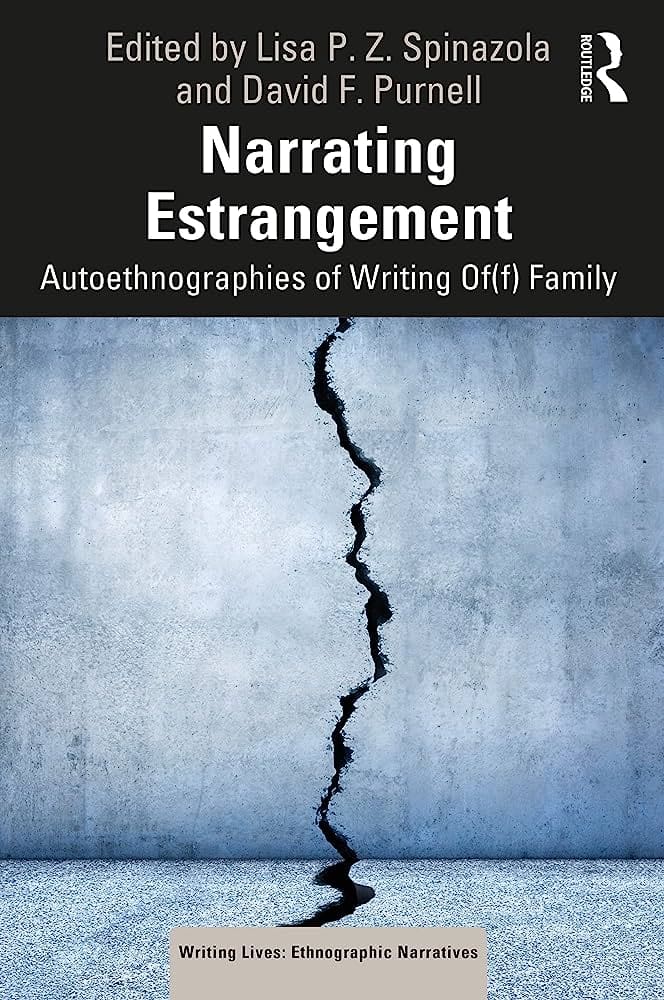Narrating Estrangement: Is the Familial Bond Inevitably Strong Life-long?
The essays collected in Narrating Estrangement are carefully curated and introduced by Lisa P.Z. Spinaloza and David F. Purnell. They engage the complexities, trappings, and toxicity of the family as a social form.
Narrating Estrangement is written by those who have decided to distance themselves, or have been driven out by, their families. The authors pose an intriguing question:
“Why do we, as a society, continue to insist on the familial bond as somehow inherently and inevitably life-long? Especially when other forms of interpersonal relations are understood as susceptible to breakage.
The editors explain: “The construct of family goes beyond the notion of permanence and includes a sense of obligation and duty. When someone makes the choice to estrange from a family member, they worry that others will blame them which can lead to feelings of guilt and shame.”
This choice, as documented across the thirteen essays that make up the volume, is not a one-time decision. Rather, it is a difficult-to-bear position that must be defended over and over across a myriad of social situations and to mostly adverse effects. The authors continue, “Because of this, we inadvertently estrange from other family members to save ourselves the grief of having to repeatedly explain ourselves or hear about the ones with whom we no longer speak.”
The writing collected here moves the reader to earnest introspection about one’s own ‘family life.’ It is vulnerable and willing to broach feelings of guilt and shame. In this precise sense, Narrating Estrangement can very much be read through as a workbook. It is a model for those interested in narrating their own experiences of estrangement.
Another intriguing aspect of the book is the discussion regarding the ethics of self-writing and self-research. Any first-person narrative, we know, inevitably involves other people who may or may not be aware of how they figure into the story being told. Several of the authors featured in the volume expressly wrestle with this concern:
“What, if any, regard should we show to the people who will be made to appear in our writing as those responsible for bringing harm or hurt upon us?
Each author addresses and answers this question differently. However, most of the essays suffer from a lack of complexity as it pertains to the representation of known and once-beloved others. They are, simply put, the villains in the story.
This lack of complexity, in my view, makes the essays read more like first-person testimonials, or pieces of therapeutic writing, than autoethnographic analysis. Autoethnography, it could be argued, requires a dose of generosity. If our self-writing is to illuminate one or more aspects of our social world, then the people who appear in our autoethnographies must be given enough leeway, so to speak, for readers to interpret their motivations, their perspectives, their sides of the story differently. Autoethnographers, perhaps, must be willing to not be always right about how key life events transpired in order to be more open and expansive in their thinking about the larger social issues they seek to illuminate.
I would be remiss, however, if I did not distinguish Trudi Peterson’s piece “Traci(ng) Estrangement: Sisters, Secrets and Suicide”. Here, the author not only pushes her thinking to understand her sister’s life and suicide, but also compliments her impressions and commentary with found documents such as her sister’s suicide note, and her journal, as well as with interviews with family members.
“Peterson shows us it is possible to follow a research agenda even as one is sorting through stories, objects and texts that shake us. These things threaten to change our understanding of others close to us, or ourselves.
The result is an essay that is as eminently readable and compelling as the others in the volume. But, it also importantly showcases the capaciousness of autoethnography as a method. Readers must consider how tragedy and grief pushes certain questions to the forefront. It asks us how it might lead those left behind to withdraw, or how it can bring them together. Moreover, Peterson shows us it is possible to follow a research agenda even as one is sorting through stories, objects and texts that shake us. These things threaten to change our understanding of others close to us, or ourselves.
All in all, Narrating Estrangement would make for a great companion text in sociology courses focusing on families. The collection feels almost therapeutic in its style. More importantly, it is a shining example of evocative self-writing.
Credits
Featured image of individuals in conflict by Gerd Altmann from Pixabay
Narrating Estrangement: Autoethnographies of Writing of(f) Family, Edited by Lisa P.Z. Spinaloza and David F. Purnell, Routledge, 2022, ISBN: 978-0-367-64337-9, 287 pages; $39.16
Learn More
New to autoethnography? Visit What Is Autoethnography? How Can I Learn More? to learn about autoethnographic writing and expressive arts. Interested in contributing? Then, view our editorial board’s What Do Editors Look for When Reviewing Evocative Autoethnographic Work?. Accordingly, check out our Submissions page. View Our Team in order to learn about our editorial board. Please see our Work with Us page to learn about volunteering at The AutoEthnographer. Visit Scholarships to learn about our annual student scholarship competition.
Guillermo Rebollo Gil (San Juan, 1979) is a writer, sociologist, translator, and attorney. He is the author of Writing Puerto Rico: Our Decolonial Moment (2018) and Whiteness in Puerto Rico: Translation at a Loss (2023). Es el papá de Lucas Imar y Elián Iré.















